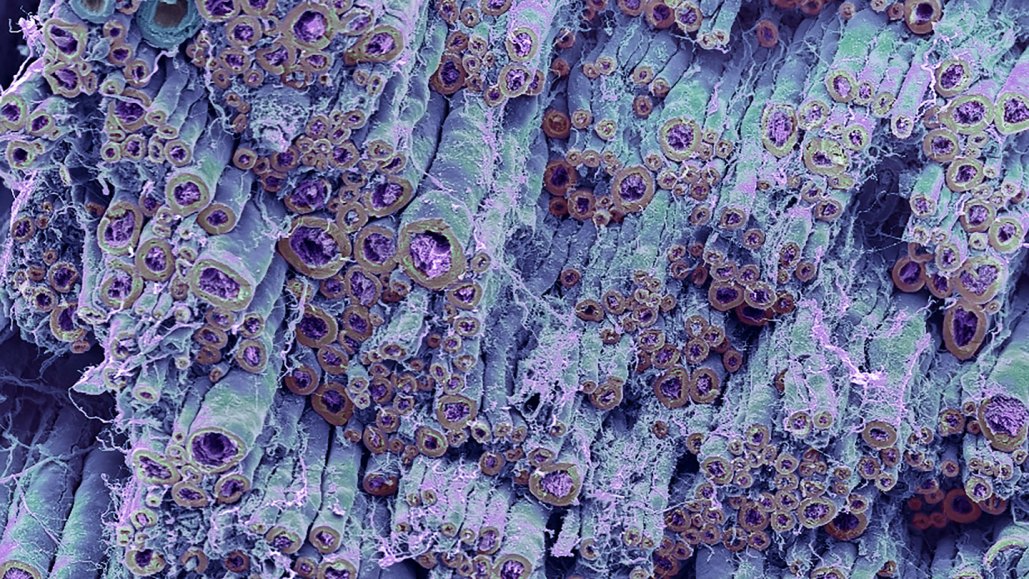The Role of Ancient Viruses in the Evolution of Fast Nerves

It appears that ancient viruses have had some beneficial effects on our nerve function.
Researchers reported in Cell on February 15 that a specific retrovirus, found in the DNA of jawed vertebrates, aids in the production of a protein essential for insulating nerve fibers. This insulation, also known as myelin, likely promoted the development of quick thinking and intricate brains.
The usefulness of this retrovirus was so profound that it consistently repeated throughout vertebrate evolution, according to the research team.
Retroviruses, which are sometimes referred to as jumping genes or retrotransposons, are RNA viruses that create DNA versions of themselves to nest in the host's DNA. Ancient virus remnants were initially considered genetic throwaways, but this perspective is evolving, says neuroscientist Jason Shepherd, who was not involved in the study.
Shepherd, a researcher at the University of Utah Spencer Fox Eccles School of Medicine, says, "Increasingly we find that these retrotransposons and retroviruses have driven life's evolution on Earth."
Residual retroviruses have previously been recognized for contributing to the evolution of the placenta, immune system, and other significant aspects of human evolution. Now, these residues are suspected of aiding in myelin production.
Myelin is a fat and protein layer that covers lengthy nerve fibers referred to as axons. The insulation of myelin improves nerve signal speed compared to a non-insulated nerve.
According to Robin Franklin, a stem cell biologist at Altos Labs-Cambridge Institute of Science, the myelin protection enables nerve fibers to be thinner and extend longer. This resilience allows for more efficient packing within the nervous system and larger animal size. "Myelination was a significant factor in the complexity of brains and the diversity of vertebrates. Without early vertebrate evolution, present vertebrate diversity would not exist," Franklin says.
While examining data retrospectively, Franklin and his team discovered considerable amounts of ancient retrovirus RNA in cells responsible for producing myelin.
This ancestral virus, RetroMyelin, doesn't code for proteins. Instead, it pairs with a protein named SOX10, which together start the production of myelin basic protein, forming a tight casing around nerve cells.
By using a genetic method to decrease RetroMyelin in the brains of rats, zebrafish, and frogs, the team observed a reduction in myelin basic protein. This suggests that RetroMyelin RNA is crucial for myelin production.
Eirene Markenscoff-Papadimitriou, a developmental neuroscientist at Cornell University not participating in the research, says this is a newly discovered function of retroviruses. She calls it "a dramatic and significant revelation ... of a novel type of developmental process enabled by these retroviruses."
Everyone from fish to amphibians and mammals, who all have vertebrae and jaws, carries RetroMyelin. However, lampreys and other jawless fish and invertebrates do not. This initially suggests that the retrovirus first appeared in the common ancestor of jawed vertebrates, yet the studied species each had their unique version of RetroMyelin. This indicates that the retrovirus infected different species at various points, leading to the same result, a characteristic known as convergent evolution.
The research isn't conclusive on why jawless vertebrates like lampreys lack RetroMyelin; it's possible that the viruses never infected them, or they did but were not evolutionarily useful and were eventually disregarded, says study co-author Tanay Ghosh, a computational biologist at Altos Labs.
Markenscoff-Papadimitriou explains, for jawed vertebrates, having all the necessary elements for myelin production in place was likely crucial to benefit from RetroMyelin. "Various viruses are constantly infecting us, and some provide an evolutionary advantage. We are witnessing the successful cases where RetroMyelin probably immediately provided an advantage to the host organism and was, therefore, retained," she adds.
Usually, researchers are interested in genes and RNAs that produce proteins. They filter out noncoding RNAs — ones like RetroMyelin that don’t produce proteins, Markenscoff-Papadimitriou says. But, she notes, scientists are increasingly recognizing that noncoding RNAs also do important jobs (SN: 4/7/19). “This paper will be an inspiration to other developmental biologists to really mine their data to look for the retrotransposons.”




